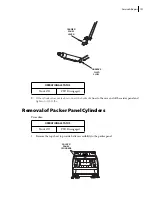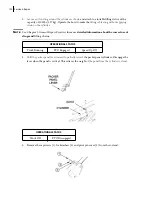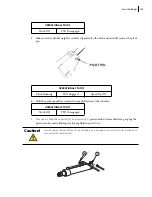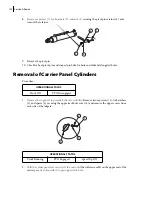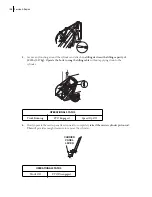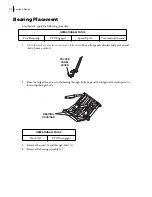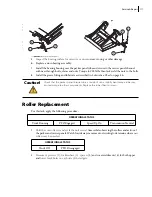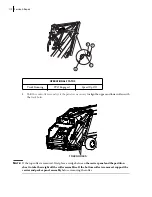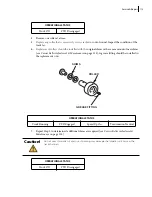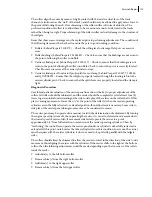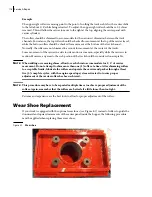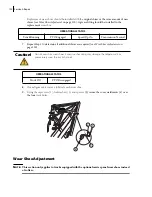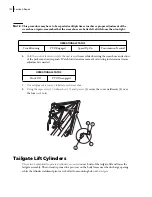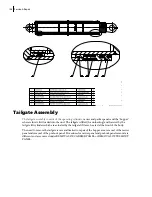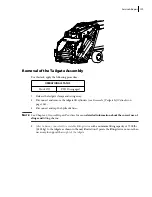
Service & Repair 115
The rollers align the carrier by means of slight contact with the inside vertical face of the track
channels (also known as the “web” of the track), and should never be allowed to apply excess force to
the point of distorting the web. Over shimming of the rollers will result in track distortion. The
preferred condition of rollers is to allow them to have a minor amount of side travel in the tracks
rather than being too tight. Proper shimming of the rollers will avoid costly damage to the structure of
the tailgate.
Items that show wear or damage must be replaced prior to performing adjustments. The condition of
the following items must be checked to ensure they are in good working condition:
Rollers (Labrie
Plus
part # 100171) – Check the rolling face for damage, flat spots or excessive
wear.
Roller bushings (Labrie
Plus
part # L100189) – Check to ensure that the bushings are not worn to
the point of allowing the roller to wobble.
Carrier cylinder pivot (Labrie
Plus
part # L100157) – Check to ensure that the bushings are not
worn to the point of allowing the roller to wobble. Check to ensure the pivot is correctly located.
Check for excessive wear at the carrier cylinder rod eye.
Carrier cylinder pivot locator roll pin & split sleeves/clamp (Labrie
Plus
part # 102577, 100162,
and QUC00890) – Ensure that the roll pin is properly located through the locating tab into the
carrier cylinder pivot. Check to ensure that the split sleeves are properly located and the clamp is
tight.
Diagnostic Procedure
Careful and patient evaluation of the carrier panel in motion is the key to proper adjustment of the
rollers. All rollers should be lubricated, and the carrier should be completely cycled at least four (4)
times to gain an initial understanding of the side to side play of the carrier on the roller shafts. If this
play is causing movement of more than ¼” at the point of the roller(s) when the carrier operating
cylinders are in the fully retracted or extended position, then adjustment is necessary. Some side to
side play of the carrier panel during movement may be considered common.
The carrier panel may be operated in a manner to aid in the determination of adjustment. By turning
the engine speed up system off, then operating the carrier, it is easier to determine movement due to
the slowed speed of carrier. Also, if movement is detected, operate the carrier to a point
approximately 2-4” from full retraction or extension of the carrier operating cylinders. Then, by
“feathering” the control lever, operate the carrier panel until one cylinder is either fully retracted or
extended. At this point, note how far the other cylinder is from this condition. In essence, the carrier
must be square with the carrier cylinders; it does not need to be perfectly parallel with the tailgate
sides.
The rollers should always be shimmed to allow the carrier to travel in the direction of the side to side
movement, thus aligning the carrier with the cylinders. If the carrier shifts to the right at the bottom
rollers, then the following adjustments would be made, depending upon the looseness of the rollers
inside the tracks:
Add shim(s) to the left bottom roller
Remove shim(s) from the right bottom roller
Add shim(s) to the right upper roller
Remove shim(s) from the left upper roller
Summary of Contents for 2R-III
Page 1: ...2R III MAINTENANCE MANUAL...
Page 2: ......
Page 3: ...2R III MAINTENANCE MANUAL...
Page 5: ......
Page 6: ......
Page 20: ...10 Introduction...
Page 42: ...32 Safety...
Page 58: ...48 Preventive Maintenance Figure 5 1 Hydraulic tank w return filter 1 2 3 4 5 6 7 8...
Page 66: ...56 Preventive Maintenance...
Page 102: ...92 Troubleshooting...

